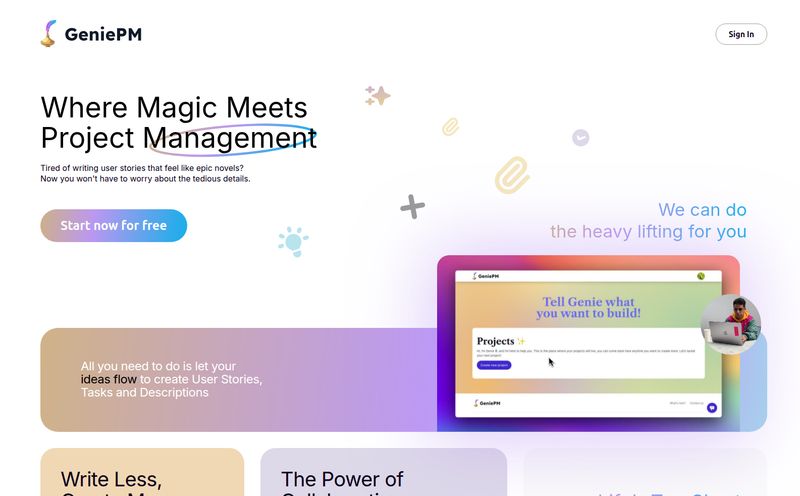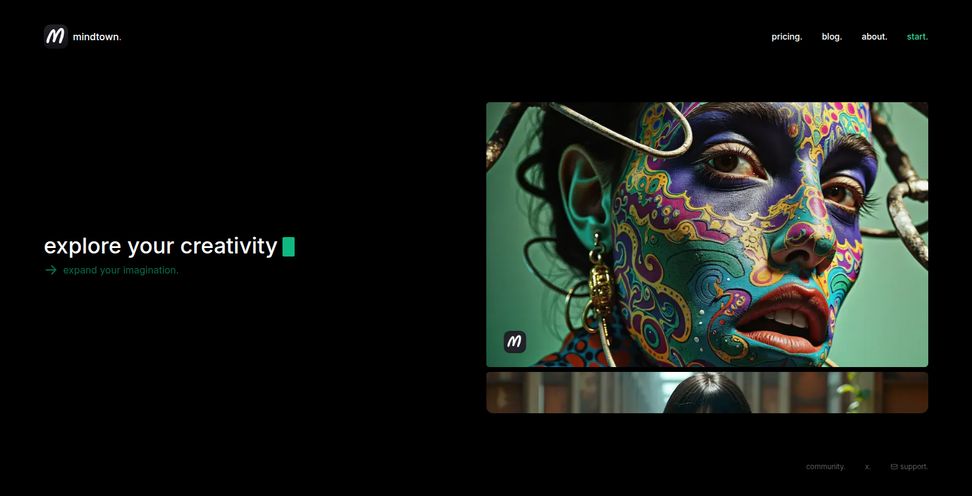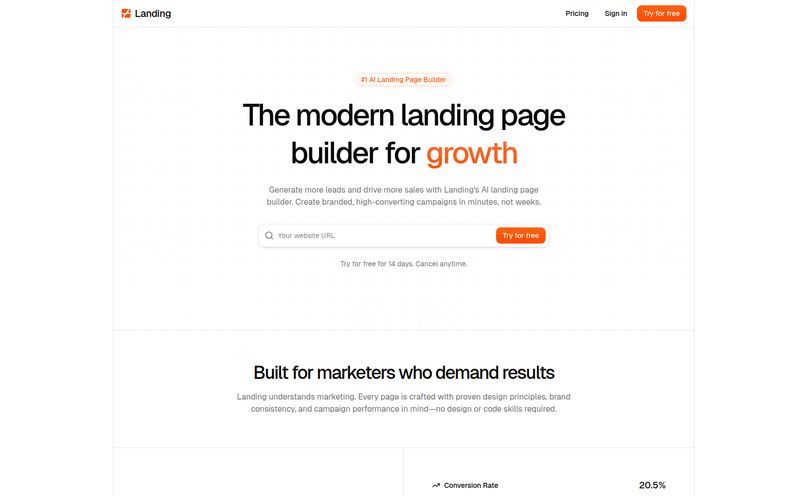The AI space right now feels like the wild west, or maybe a massive, sprawling digital flea market. Every single week there’s a new “game-changing” tool that promises to revolutionize how we create content, design images, or write code. My bookmarks folder is a graveyard of free trials and “I’ll check this out later” links. It’s exhausting, and my wallet is frankly terrified of picking up another monthly subscription.
We’re all juggling a half-dozen different platforms – one for writing, another for image generation, a third for upscaling those images, and so on. It's a classic case of what the industry calls 'tool sprawl'. So, when I stumbled upon a company called Kites.Dev, which pitches itself as a provider of a whole suite of AI SaaS products, my curiosity was definitely piqued. Could this be the integrated solution? The neat, tidy toolbox instead of a chaotic pile of wrenches and screwdrivers?
So, What Exactly is Kites.Dev?
Digging into their “About Us” page, you get the sense of a company with big ambitions. Founded back in 2019 – which, in AI years, is practically a decade ago – they call themselves a “trailblazing software company” with a “relentless passion for innovation.” Okay, a little bit of marketing fluff, but what company doesn't do that? The core idea is that they’re not just building one-off tools. They're trying to create an ecosystem.
They aim to provide AI solutions for businesses, focusing on the holy trinity of modern content needs: image generation, content creation, and image enhancement. The promise is an end to the madness of app-switching. It’s an attractive proposition, for sure. But does the reality match the pitch?

Visit Kites.Dev
A Look Inside the Kites.Dev AI Toolkit
This is where things get interesting. Kites.Dev isn’t just one product; it’s a portfolio of distinctly named applications, each targeting a specific creative need. It reminds me a bit of the Adobe Creative Cloud, but specifically for AI-driven tasks.
For the Visual Creators: Draw3D and Pictush
Right off the bat, two tools stand out for anyone working with visuals. Draw3D is their AI image generator. The name suggests it might have a focus on three-dimensional assets or styles, which could be a massive deal for game designers, architects, or product prototypers. Then there’s Pictush, their tool for AI-powered image enhancement and restoration. This is a workhorse tool every marketer needs. Think of all the times you’ve been handed a grainy, low-res logo or an old, faded photograph. A tool like Pictush promises to be that AI magic wand, sharpening details and restoring color without hours of manual Photoshop work.
For the Storytellers: Pictales
Now this one I find particularly cool. Pictales is an AI that generates stories from images. The potential applications here are just fascinating. A social media manager could use it to instantly create engaging captions for a photo. A children's book author could use an illustration as a prompt to kickstart a narrative. It's a creative bridge between the visual and the textual, a space where a lot of AI tools don’t really play.
The Big Picture Platforms: LumuzAI and UltimateApp
This is where Kites.Dev seems to be targeting the enterprise crowd. They list LumuzAI as an “all-in-one AI platform” and UltimateApp as an “Ultimate AI solutions hub.” To be honest, the distinction isn’t crystal clear from the outside. My hunch is that these are the containers—the dashboards or platforms through which businesses can access and manage the other tools like Draw3D and Pictales. This points towards a focus on integrated workflows for larger teams, not just individual creators.
The Elephant in the Room... The Missing Pieces
So after getting all excited about a unified AI world, I did what any of us would do. I went looking for the pricing page. The ‘sign up’ button. The ‘get started for free’ link. And I found… well, this:
"Sorry, the page you are looking for could not be found. It's just an accident that was not intentional."
A 404 error. A dead end. This, for me, is the biggest red flag. It’s not just the lack of a pricing page; there's a general scarcity of deep information. We know what the tools are called, but we dont know their specific capabilities. What's the max resolution for Pictush? What AI model does Draw3D run on? Can Pictales write in different tones of voice? It's a bit of a black box.
This lack of transparency usually points to one thing: a sales-led, enterprise-first strategy. They don't want individuals signing up for $10 a month. They want to get on a call with a VP of Marketing and sell them a five-figure annual contract. There's nothing wrong with that business model, but it’s a bit of a letdown for the rest of us scrappy creators and small businesses.
Kites.Dev Pros and Cons at a Glance
For those of you who just skim (I see you), here’s the quick and dirty breakdown.
| What I Liked | What Gave Me Pause |
|---|---|
| A diverse suite of AI tools from one company. | Pricing is completely unavailable. Big red flag. |
| Covers image creation, enhancement, and content generation. | Very little detail on the specific features of each tool. |
| Clear focus on enterprise and all-in-one solutions. | Seems geared towards enterprise clients, not individuals. |
My Final Take on Kites.Dev
I am genuinely intrigued by Kites.Dev. The idea is fantastic. In a world suffering from severe subscription fatigue, a single, competent vendor for multiple AI needs is a powerful proposition. The toolset they've outlined—from 3D drawing to story generation—is smart and covers real-world use cases.
However, an idea is only as good as its execution, and right now, their go-to-market strategy feels... hidden. The lack of public pricing and detailed documentation creates a huge barrier. It’s like seeing a beautiful restaurant with blacked-out windows and no menu posted outside. You're pretty sure it's expensive, and you have no idea if you'll even like the food.
My advice? Keep Kites.Dev on your radar. If they eventually open up with more transparent pricing tiers and public-facing demos, they could become a serious player. For now, they remain an interesting but inaccessible curiosity for most of us. It’s a platform with a ton of potential, but it needs to open the front door if it wants to invite the world in.
Frequently Asked Questions about Kites.Dev
What is Kites.Dev?
Kites.Dev is a software company founded in 2019 that develops a suite of AI-powered SaaS (Software as a Service) products for businesses. Their tools focus on image generation, content creation from images, and image enhancement.
What are the main products offered by Kites.Dev?
Their main products include Draw3D (AI image generation), Pictales (AI story generation from images), Pictush (AI image enhancement), and two platform solutions, LumuzAI and UltimateApp, which seem to be all-in-one hubs for their tools.
Is Kites.Dev free to use?
There is no public information about pricing on their website. The lack of a pricing page or free sign-up option strongly suggests it is a paid service that requires contacting their sales team for a custom quote, likely targeting businesses rather than individual users.
Who should use Kites.Dev?
Based on their product suite and lack of public pricing, Kites.Dev appears to be best suited for medium-to-large businesses and creative agencies who need an integrated set of AI tools and are willing to engage in a sales process for a custom enterprise solution.
How is Kites.Dev different from tools like Midjourney or ChatGPT?
The main difference is the approach. While tools like Midjourney or ChatGPT are highly specialized for one function (image generation or text generation), Kites.Dev aims to be a multi-functional platform, offering a variety of distinct but integrated tools under one roof.
Where can I find Kites.Dev pricing?
You can't find it publicly. As of late 2024, their website does not list any pricing. To get a quote, you would most likely need to use their 'Contact' page to get in touch with their team directly.
References and Sources
- Kites.Dev Official Website
- 'The hidden costs of SaaS sprawl' - TechCrunch article on the challenges of managing too many software tools.



